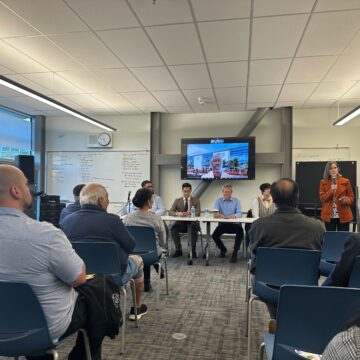Milpitas needs to find ways to build more affordable housing and preserve what it already has.
That’s according to housing advocates and policymakers who discussed the city’s affordable housing stock at a Thursday panel hosted by San José Spotlight. The state is requiring Milpitas to add 6,713 homes by 2031, with more than half being below market rate—a requirement the city has struggled to meet in the past. All panelists agreed funding is the biggest barrier to building more affordable housing in Milpitas and the greater Silicon Valley region.
“At the end of the day, we can try to come up with policy solutions, we can amend specific plans and whatnot, but it comes down to money,” Milpitas Councilmember Anthony Phan said. “That’s going to be the largest factor for the developer (and) for the city.”
Phan spoke alongside other panelists including Huascar Castro, director of housing and transportation policy at Working Partnerships USA, and Silicon Valley at Home Policy Director Mathew Reed. The Santa Clara County Housing Authority sponsored the event.
Money to support housing development comes from a variety of sources, including county and state grants and budget allocations. Reed underscored the importance of local match funding, which he said is a challenge everywhere. He said cities changing zoning restrictions can decrease the resources needed to build affordable housing.
“There’s ways of creating cost savings there that allow us to leverage stuff that’s not just money to make things more attractive,” Reed said.
Another funding source is through various partnerships to meet certain needs, including working with companies to develop housing to support a certain workforce or working with the county or state to secure funding avenues.
One such partner is the Milpitas Unified School District. Phan talked about a development project at 1355 California Circle expected to provide 206 homes, the majority of which will be school district workforce housing.
About 40% of Milpitas renters spend more than a third of their income on rent, meaning they’re rent burdened. Castro said looking at tenant protections will be important for the city to keep vulnerable residents from being displaced or falling into homelessness.
Milpitas has 274 homeless residents according to the county’s 2022 point-in-time count, which is considered an undercount. The city has historically faced criticism for a lack of unhoused support.
“There’s a lot of room for Milpitas to do more for the renters, which make up a significant amount of Milpitians,” Castro said.
Other partnerships could preserve existing affordable housing or support tenants, as Castro said the city could partner with nonprofit organizations to maintain existing affordable housing.
Reed added that an example of preserving affordable housing has been playing out around the Sunnyhills Apartments. The complex offers 149 subsidized apartments, which he said holds about 15% of the city’s affordable housing stock. Developer JMK Investments renewed its contract with the U.S. Department of Housing and Urban Development earlier this year.
“The general point is that we have very few homes that people can afford and we’re risking losing the ones that we have,” Reed said.





